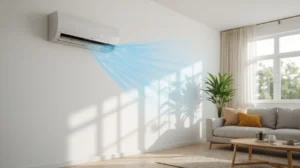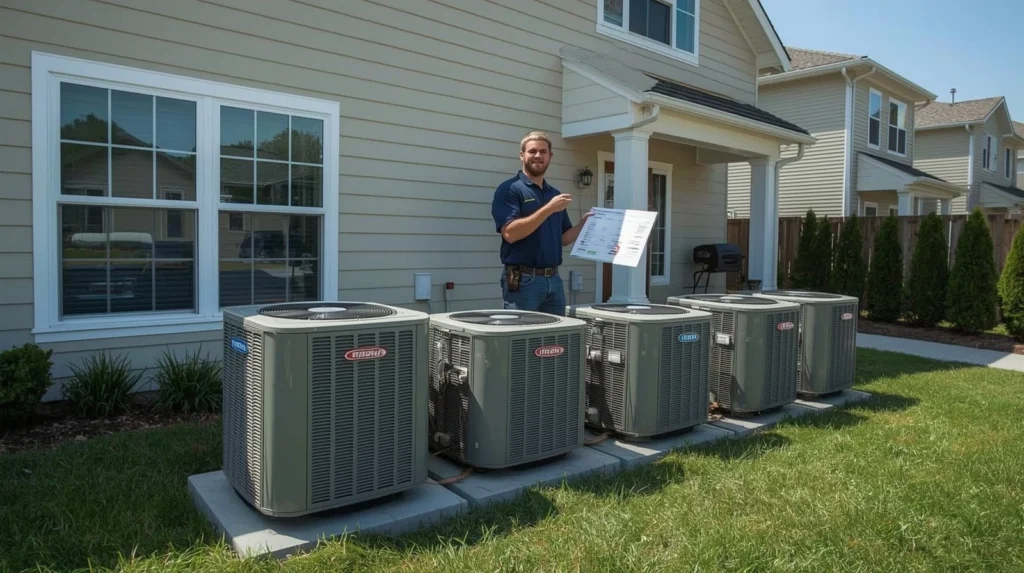When it gets hot in the summer, you need the right air conditioner to stay cool. But how do you know what size is best? You shouldn’t just pick an air conditioner based on price or looks, you should also make sure it can cool your space well. If you pick the wrong size, it might not work well or at all, and your energy bills will go up. The question “What size AC unit do I need?”
Why Choosing the Right AC Size Matters

Before you buy an air conditioner, you should know how the BTU number affects how well it cools. The British Thermal Unit (BTU) tells you how much heat an air conditioner can take out of a room in one hour. This grade will help you pick the right size AC.
If you choose a unit that is too small, it will have a hard time cooling your space, so it will run all the time, which will raise your electricity bill. A unit that is too big, on the other hand, will cool the room too quickly, which will cost a lot of money and cause the humidity levels to change all the time. An air conditioner that is the right size will be both efficient and comfortable. So, getting the right size AC does more than just keep you cool; it also impacts your budget.
How to Calculate the AC Size You Need
Now let’s talk about how to figure out what size AC unit you need. Finding out how many square feet your room is is the easiest way to do it. You’ll need about 5,000 BTUs for every 100 to 150 square feet of living space. But this doesn’t look at things like the room’s ceiling height, insulation, or how much sunshine it gets.
Here’s how you can get a rough estimate of the required AC size:
Measure the Room: Find the square footage by multiplying the length by the width.
Account for Room Factors: If your room has poor insulation or large windows with direct sunlight, you may need to increase the BTU rating by 10-20%.
Final Calculation: Multiply your room’s square footage by 25 (for a standard room) and then adjust for any additional factors. This should give you the necessary cooling capacity in BTUs.
Understanding BTU Ratings and Room Sizes
When it comes to selecting the correct air conditioner, understanding the relationship between BTU ratings and room sizes is essential. Here’s a handy chart to help you match the right BTU to your room size for effective cooling:
| Room Size (Square Feet) | Required BTU |
|---|---|
| 100 – 150 sq ft | 5,000 – 6,000 BTU |
| 150 – 250 sq ft | 6,000 – 8,000 BTU |
| 250 – 400 sq ft | 8,000 – 12,000 BTU |
| 400 – 600 sq ft | 12,000 – 18,000 BTU |
| 600 – 1,000 sq ft | 14,000 – 18,000 BTU |
| 1,000 – 1,500 sq ft | 18,000 – 22,000 BTU |
| 1,500 – 2,000 sq ft | 22,000 – 30,000 BTU |
This table will give you a quick reference to the cooling capacity needed based on room size.
Choosing the Right AC for Specific Room Sizes
Here’s a breakdown of what size AC unit is appropriate for different room sizes. This will help you choose the best air conditioner for your home or office.
| Room Size | AC Size Needed (BTU) | AC Size Needed (Tons) |
|---|---|---|
| 600 sq ft | 8,000 – 10,000 BTU | 0.67 – 0.83 tons |
| 1,000 sq ft | 12,000 – 14,000 BTU | 1 – 1.17 tons |
| 1,500 sq ft | 18,000 – 22,000 BTU | 1.5 – 1.83 tons |
| 2,000 sq ft | 24,000 – 30,000 BTU | 2 – 2.5 tons |
| 3,000 sq ft | 36,000 – 45,000 BTU | 3 – 3.75 tons |
This chart can guide you to the right unit for your room, based on its square footage.
Different Types of AC Units and Their Sizing
Different types of air conditioners require different sizes for effective cooling. Here’s a chart comparing some common types and their typical sizing ranges.
| Type of AC Unit | Cooling Capacity (BTU) | Typical Use |
|---|---|---|
| Window AC Unit | 5,000 – 12,000 BTU | Small to medium-sized rooms |
| Portable AC Unit | 8,000 – 12,000 BTU | Small rooms or specific spaces like RVs |
| Mini-Split AC System | 12,000 – 36,000 BTU | Larger rooms, multi-zone cooling |
| Central Air Conditioning | 24,000 – 60,000+ BTU | Whole house cooling |
Use this table to get a clearer idea of the BTU range needed for different AC types depending on your space.
What Happens If Your AC Unit Is Too Small or Too Big?
Not only will an AC unit that is too small struggle to cool the room, it will also work too hard, which will raise your power bills and shorten the unit’s life. People will notice that the room stays warm even when the AC is on full blast, and the air may feel damp.
On the other hand, a unit that is too big cools down too fast, which stops it from properly removing humidity. This could make the air feel chilly and damp. Also, keep in mind that bigger units can cost more to install, so picking the right size will save you money right away.
Using an AC Sizing Chart for Quick Reference
To make things easier, a lot of websites and HVAC experts offer helpful size charts to help you choose an AC. There are charts that show the right BTU for each room size, such as 1 ton for 600 square feet and 2 tons for 1,200 square feet. You can use these plans to get a rough idea, but don’t forget to make changes based on how your room is set up.
Common Mistakes to Avoid When Sizing Your AC
Here are a few mistakes people often make when choosing an AC unit:
Ignoring ceiling height: Taller ceilings require more cooling capacity.
Not considering insulation: Poor insulation increases the need for a larger unit.
Choosing by price alone: The cheapest option might not be the most efficient.
To avoid these mistakes, it’s always a good idea to use an online calculator or consult with an HVAC expert.
Expert Tips for Maximizing Cooling Efficiency
Once you’ve chosen the right-sized AC unit, you can further enhance its performance with proper maintenance. Here are a few tips:
Clean filters regularly to ensure airflow remains optimal.
Seal any gaps around windows and doors to prevent cool air from escaping.
Use fans to circulate the cool air and help the unit cool more efficiently.
By maintaining your AC and using it smartly, you’ll not only stay cool but also extend the life of your unit.
Conclusion
Picking the right AC size is important for both comfort and efficiency. You can make sure that your AC unit fits perfectly in your room by learning about BTU rates, figuring out how much air flow the room needs, and using size charts. Please don’t be afraid to talk to professionals to get the best advice and enjoy the cool, comfortable home you deserve.
Get the Perfect AC Size — Installed by Local Experts
We’ll help you choose the right AC unit for your home and install it professionally for maximum comfort and savings.
Frequently Asked Questions (FAQs)
How do I determine the correct size of an AC unit for my room?
To find the right size, increase the sq. footage of the room by 20 to 30 BTUs per square foot. Like, a 300-square-foot room needs between 6,000 and 9,000 BTUs. For more realism, think about things like sunlight and insulation.
What are the risks of installing an undersized or oversized AC unit?
Overworking a unit that is too small will cause your energy bills to go up and the cooling to not work well. If the unit is too big, it cools too quickly and doesn’t get rid of enough humidity, leaving the room feeling damp. Both can make things less comfortable and cost more.
Is there a simple rule of thumb for AC sizing?
20 to 30 BTUs per square foot is a good rule of thumb. Like, a room that’s 1,000 square feet needs about 12,000 to 15,000 BTUs. This method gives you a rough idea, but you should take into account things like the room’s insulation or openings.
Should I rely on online calculators for AC sizing?
Online calculators are a good starting point but don’t account for factors like insulation or sunlight. For a precise recommendation, it’s best to consult an HVAC professional. They can consider all details for an accurate estimate.
What are the signs that my AC unit is too small for my space?
It might be too small if your air conditioner runs all the time but doesn’t cool the room or if some parts of it stay warm. High humidity and higher energy bills are also signs that the unit is too small. Think about upgrading if these problems keep happening.









